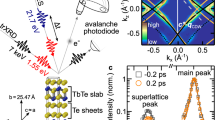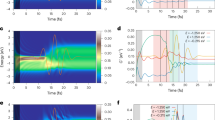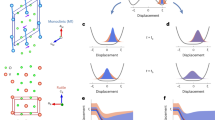Abstract
The electrical conduction of metals is governed by how freely mobile electrons can move throughout the material. This movement is hampered by scattering with other electrons, as well as with impurities or thermal excitations (phonons). Experimentally, the scattering processes of single electrons are not observed, but rather the overall response of all mobile charge carriers within a sample. The ensemble dynamics can be described by the relaxation rates, which express how fast the system approaches equilibrium after an external perturbation1,2,3. Here we measure the frequency-dependent microwave conductivity of the heavy-fermion metal UPd2Al3 (ref. 4), finding that it is accurately described by the prediction for a single relaxation rate (the so-called Drude response5). This is notable, as UPd2Al3 has strong interactions among the electrons4 that might be expected to lead to more complex behaviour. Furthermore, the relaxation rate of just a few gigahertz is extremely low—this is several orders of magnitude below those of conventional metals (which are typically around 10 THz), and at least one order of magnitude lower than previous estimates for comparable metals. These observations are directly related to the high effective mass of the charge carriers in this material and reveal the dynamics of interacting electrons.
This is a preview of subscription content, access via your institution
Access options
Subscribe to this journal
Receive 51 print issues and online access
$199.00 per year
only $3.90 per issue
Buy this article
- Purchase on Springer Link
- Instant access to full article PDF
Prices may be subject to local taxes which are calculated during checkout


Similar content being viewed by others
References
Ashcroft, N. W. & Mermin, N. D. Solid State Physics (Saunders College Publishing, Fort Worth, 1976)
Ziman, J. M. Principles of the Theory of Solids (Cambridge Univ. Press, Cambridge, 1972)
Dressel, M. & Grüner, G. Electrodynamics of Solids: Optical Properties of Electrons in Matter (Cambridge Univ. Press, Cambridge, 2002)
Geibel, C. et al. Heavy-fermion superconductivity at Tc = 2K in the antiferromagnet UPd2Al3 . Z. Phys. B 84, 1–2 (1991)
Drude, P. Zur Ionentheorie der Metalle. Phys. Z. 1, 161–165 (1900)
Grewe, N. & Steglich, F. in Handbook on the Physics and Chemistry of Rare Earths (eds Gschneidner, K. A. Jr & Eyring, L.) Vol. 14, 343–474 (Elsevier, Amsterdam, 1991)
Varma, C. M. Phenomenological aspects of heavy fermions. Phys. Rev. Lett. 55, 2723–2726 (1985)
Millis, A. J. & Lee, P. A. Large-orbital-degeneracy expansion for the lattice Anderson model. Phys. Rev. B 35, 3394–3414 (1987)
Webb, B. C., Sievers, A. J. & Mihalisin, T. Observation of an energy- and temperature-dependent carrier mass for mixed-valence CePd3 . Phys. Rev. Lett. 57, 1951–1954 (1986)
Degiorgi, L. The electrodynamic response of heavy-electron compounds. Rev. Mod. Phys. 71, 687–734 (1999)
Donovan, S., Schwartz, A. & Grüner, G. Observation of an optical pseudogap in UPt3 . Phys. Rev. Lett. 79, 1401–1404 (1997)
Dressel, M. et al. Nature of heavy quasiparticles in magnetically ordered heavy fermions UPd2Al3 and UPt3 . Phys. Rev. Lett. 88, 186404 (2002)
Pines, D. & Nozières, P. The Theory of Quantum Liquids Vol. I, Normal Fermi Liquids (Benjamin, New York, 1966)
Degiorgi, L. et al. The electrodynamic response of heavy-electron materials with magnetic phase transitions. Z. Phys. B 102, 367–380 (1997)
Scheffler, M. & Dressel, M. Broadband microwave spectroscopy in Corbino geometry for temperatures down to 1.7 K. Rev. Sci. Instrum. 76, 074702 (2005)
Huth, M., Kaldowski, A., Hessert, J., Steinborn, T. & Adrian, H. Preparation and characterization of thin films of the heavy fermion superconductor UPd2Al3 . Solid State Commun. 87, 1133–1136 (1993)
Jourdan, M., Huth, M. & Adrian, H. Superconductivity mediated by spin fluctuations in the heavy-fermion compound UPd2Al3 . Nature 398, 47–49 (1999)
Bonn, D. A., Garrett, J. D. & Timusk, T. Far-infrared properties of URu2Si2 . Phys. Rev. Lett. 61, 1305–1308 (1988)
Singley, E. J., Basov, D. N., Bauer, E. D. & Maple, M. B. Optical conductivity of the heavy fermion superconductor CeCoIn5 . Phys. Rev. B 65, 161101(R) (2002)
Brown Holden, A. A., Wardlaw, G. M., Reedyk, M. & Smith, J. L. Emergence of coherent transport in UBe13: an optical investigation in both the normal and superconducting states. Phys. Rev. Lett. 91, 136401 (2003)
Dordevic, S. V., Basov, D. N., Dilley, N. R., Bauer, E. D. & Maple, M. B. Hybridization gap in heavy-fermion compounds. Phys. Rev. Lett. 86, 684–687 (2001)
Beyermann, W. P., Grüner, G., Dalichaouch, Y. & Maple, M. B. Relaxation-time enhancement in the heavy-fermion system CePd3 . Phys. Rev. Lett. 60, 216–219 (1988)
Awasthi, A. M., Degiorgi, L., Grüner, G., Dalichaouch, Y. & Maple, M. B. Complete optical spectrum of CeAl3 . Phys. Rev. B 48, 10692–10700 (1993)
Tran, P., Donovan, S. & Grüner, G. Charge excitation spectrum in UPt3 . Phys. Rev. B 65, 205102 (2002)
Burke, P. J., Spielman, I. B., Eisenstein, J. P., Pfeiffer, L. N. & West, K. W. High frequency conductivity of the high-mobility two-dimensional electron gas. Appl. Phys. Lett. 76, 745–747 (2000)
Acknowledgements
The authors thank the Deutsche Forschungsgemeinschaft (DFG) for financial support.
Author information
Authors and Affiliations
Corresponding author
Ethics declarations
Competing interests
Reprints and permissions information is available at npg.nature.com/reprintsandpermissions. The authors declare no competing financial interests.
Rights and permissions
About this article
Cite this article
Scheffler, M., Dressel, M., Jourdan, M. et al. Extremely slow Drude relaxation of correlated electrons. Nature 438, 1135–1137 (2005). https://doi.org/10.1038/nature04232
Received:
Accepted:
Issue Date:
DOI: https://doi.org/10.1038/nature04232
This article is cited by
-
Propagation of shear stress in strongly interacting metallic Fermi liquids enhances transmission of terahertz radiation
Scientific Reports (2021)
-
Holographic axion model: A simple gravitational tool for quantum matter
Science China Physics, Mechanics & Astronomy (2021)
-
High Speed Terahertz Modulator on the Chip Based on Tunable Terahertz Slot Waveguide
Scientific Reports (2017)
-
Accessing the fundamentals of magnetotransport in metals with terahertz probes
Nature Physics (2015)
Comments
By submitting a comment you agree to abide by our Terms and Community Guidelines. If you find something abusive or that does not comply with our terms or guidelines please flag it as inappropriate.



